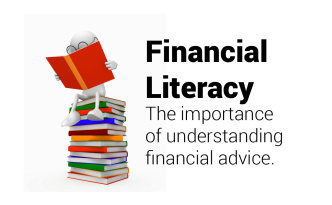
Financial literacy is the ability to understand issues related to personal finance and manage them judiciously. Only a financially literate person is able to update his knowledge continuously for responding effectively to ever-changing personal and economic circumstances.
The absence of financial literacy
can damage substantially the interests of the persons concerned.
Most of the times, it harms the concerned person indirectly. The
damage isn’t visible because the affected person is unable to
visualize it. He doesn’t come to know what he is losing and so he
can’t measure the damage. This is how the real problem starts that
people don’t realize their unawareness and further they aren’t
willing to accept it. It makes people averse to change their
financial habits.
To increase financial literacy is the need of the hour. We have been organising financial literacy sessions or quizes for schools, colleges, institutions, corporates, residential complex etc. Please contact us @ 9334117776 for such sessions.

Financial Glossary: to empower individuals with the financial knowledge necessary to understand the basics of finance
Increase in the value of an asset such as a stock, bond, commodity or real estate.
Interest earned not only on the initially invested principal but also on accumulated interest during the period.
A security whose price is affected by ups and downs in the overall economy is cyclical stock. Examples are shares of industries as construction, automobile, engineering or those affected by the international economy such as shipping, aviation, and tourism. Cyclical stocks are also stocks which are affected by the natural environment such as fertilisers and tea. Contrast cyclical stocks with counter-cyclical stocks, which tend to move in the opposite direction from the overall economy, and with consumer staples, which people continue to demand even during a downturn such as drugs, insurance basic foodstuffs etc.
This risk arises from the change in price of one currency against another. Investors and multinational businesses exporting or importing goods and services or making foreign investments throughout the global economy are faced with this type of risk.
Debt funds are the mutual funds which combine the feature of capital appreciation with safety. They invest in various types of debt securities issued by different issuers having different characteristics. These debt securities such as Treasury bills, G-secs, Certificate of Deposits (CDs), Commercial Papers (CPs), Bonds and money market securities are market tradable and provide the scope of capital gain apart from interest. Especially in India, where the debt markets are underdeveloped, debt funds are sometimes the only way to invest in the debt market. These funds also score over direct investment in a bond because they offer diversification, liquidity, tax benefit, experts’ touch and convenience of investing. Multiplicity of dividend options (daily, weekly, fortnightly, monthly) makes them more lucrative.
Exchange Traded Funds (ETFs) are the investing innovation that combines the best features of mutual funds, especially index funds, with the trading flexibility of individual securities. Globally they are widely used by planners as the efficient and cost effective tool to take advantage of investment opportunities around the world. In India, they have witnessed major developments over the past couple of years.
Expense ratio indicates how much an investor pays a fund ( in percentage term) every year to manage his money.
A Non-resident Individual of Indian Nationality or Indian Origin can open a FCNR account to retain their money in foreign currency in India which eliminates the risk of fluctuations in currency conversion.
FIIs are institutions established or incorporated outside India which are registered with SEBI to make investments in India in securities.
Indexation is a technique to adjust income payments by means of a price index, in order to maintain the purchasing power of the public after inflation. Under Indexation, the cost of the asset is inflated as per the government notified inflation factor. The central government specifies an index linked to the wholesale price index. The indices of two years (year of purchase and the year of sale) are used for the purpose of computing capital gains tax.
The rate of return earned by a bond if it is held until the maturity date. The calculation of YTM takes into account the current market price, par value, coupon interest rate and time to maturity. It is also assumed that all coupons are reinvested at the same rate.
A line that plots the interest rates or yield vis-à-vis maturity dates. If short-term rates are lower than long-term rates, it is a positive yield curve, if short-term rates are higher, it is a negative or inverted yield curve. If there isn't much difference, it is a flat yield curve. The shape of the yield curve is closely scrutinized because it helps to give an idea of future interest rate change and economic activity.